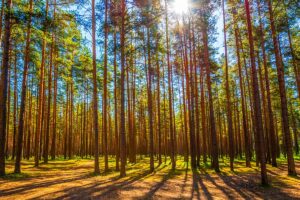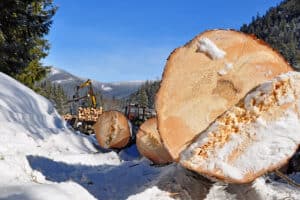(Part I of this series presented a sample cruise that will be referred to in this column.)
The seller of a timberland tract may be tempted to overstate the extent and value of his stumpage. Some foresters working for such sellers have been known to structure cruise information toward that end. In Part II, I discussed three ways of doing this: 1) counting volume on inoperable acreage; 2) using the wrong scale; and 3) counting small-diameter trees as sawtimber. Here are three more ways to construct a bogus cruise.
4. Grouping species into families and using the price multiplier for the highest species as the straight-through price. Natural forest tracts frequently contain different species from the same family of trees. Each oak species, to take one example, will have its own price, based on local market conditions.
Red oak might be priced at $300/1000bf, with black oak, scarlet oak, pin oak and chestnut oak, among others, priced lower. The spread between red oak and chestnut oak in this example is $200/1000bf. On 10,000 feet of “oak,” $300/1000bf amounts to $3,000 whereas there might be only half that value when each oak species volume is priced individually.
I’ve seen cruises that package chestnut oak volume into white-oak volume and price both at the white-oak price multiplier, which is higher. Timber buyers will disaggregate species, pricing each one individually. Sometimes mills will sell chestnut oak as white oak, but they won’t pay white-oak stumpage price for chestnut oak.
5. Breaking the tops too high. Local markets determine the acceptable diameter at the small end of a sawlog. Foresters in the field “break” their estimate of sawlog volume as they “go up” the tree visually at that threshold diameter. That might be at 10” in hardwoods, but in some circumstances the market might allow them to break higher, up to a 6” diameter. The higher the break, the more volume that’s included and priced as sawlog.
If the market for the tract’s timber is pulp or chips, top break will be high, as much as a 4” diameter. But sawlogs are generally broken at 10”, though some markets may go to 8”. If the local market requires a sawlog with a small diameter end at no less than 10”, all the volume that’s above that diameter cannot be counted and valued as sawlog volume in a cruise. If a forester breaks at 6” where the local market breaks at 10”, all the stem volume between the 10” diameter and the 6 is phantom value. The sawlog buyers won’t pay for it. A buyer must determine from the forester who did the seller’s cruise what diameter break he used, and then what break the market uses. Breaking too high is a common trick.
6. Counting trees that should not be counted as sawtimber. One of the many bad consequences of repeated high-grading of hardwood tracts is the long-term change in the timber stand from higher-value species to lower-value species. High-grading is the practice of cutting only the high-value sawtimber and leaving all culls and low-value species standing. High-grading is an efficient method for a logger to use, but the value of the landowner’s timber stand is slowly degraded by allowing the culls and low-value species to remain, taking up resources that would be applied more profitably to higher-value species..
A high-graded tract often contains many low-value species with large diameters along with large-diameter, high-value culls—both of which may have commercial value as pulp or firewood, but not sawtimber.
Foresters are expected to separate sawtimber with value as sawlogs from sawtimber-sized culls. If they do not, they are adding in volume as sawlogs that a timber buyer will only value as pulp, if at all. A landowner can improve his timber stand by insisting that the logger, at the very least, drop these trees, thus releasing small-diameter, high-value species from their competition.
Where an inexperienced land buyer finds very large diameter trees, he must determine whether they are leftovers from earlier high-gradings or valuable sawtimber.
This content may not be used or reproduced in any manner whatsoever, in part or in whole, without written permission of LANDTHINK. Use of this content without permission is a violation of federal copyright law. The articles, posts, comments, opinions and information provided by LANDTHINK are for informational and research purposes only and DOES NOT substitute or coincide with the advice of an attorney, accountant, real estate broker or any other licensed real estate professional. LANDTHINK strongly advises visitors and readers to seek their own professional guidance and advice related to buying, investing in or selling real estate.









Great article(s). I am an appraiser and will probably never really use this information, but I do like having an inkling of knowledge about it. I don’t like it too much when land owners talk over my head. While I’m not trying to be an expert on “forestry” issues, I like to at least be able to have a slight understanding of what they’re saying. Thanks.
Curtis, The timber cruiser should tally each tree based on its grade, diameter and merchantable height. While mill top specifications are considered in the cruise job control the cruiser should estimate the log height to the place where the logger will cut it off when properly merchandising the tree. Top diameters are only meaningful when the trees can carry a straight bole length to meet the mill top specifications. Many trees will be cut off at branch whorls or scars, etc. way before they reach the mill top specifications. This , in my opinion, is where the “rubber meets the road”. The rest of the bole, including branches and limbs, is considered as top wood or pulpwood.
A trip to a good logging job in the woods is good advice to illustrate the above points. Get a Consulting Forester to arrange a trip. It will enlighten you. If you were to scale some tree length logs at a mill you will find that many of the grade logs are cut off way below the mill top specifications due to defect, knots, limbs, sweep ,scars and other defects.
Correctly estimating merchantable Height is the main variable in volume estimation and measuring height through limbs,scars and other defects past the point of optimum merchantability can lead to overblown volume and value estimates.
The form class, FC, that is used can also lead to errors as well as faulty sampling procedures and poor field work field. The weight conversion factors from Mbf to tons or vice versa should also be consistent with market product utliization standards.
In every instance the buyer when reviewing a timber cruise should remember that product specifications and utilization standards vary from market to market and prices fluctuate thus a reliable timber cruise can be out of date very quickly, especially in the timber markets today.
As I have said in past responses “Buyer Beware”. Hire and retain unbiased, licensed, Registered Foresters and be willing to spend the money to make sure you are safe before buying timbered property.
In most states in the southeast U.S professional foresters are subject to disciplinary procedures of State Forestry Registration Boards for inappropriate, reckless or fraudulent work. Unfortunately in many states anyone who drives a muddy 4X4 pickup truck and works in the woods is assumed by the public, Realtors and a lot of buyers to be a professional forester and that my friends is not the case.The timber valuation business is not for amateurs. Do your homework!
Mr. Travis’s point deserves a response.
He is certainly correct in laying out the method by which foresters should tally trees using grade, diameter, merchantable height, species, etc.
The point I made in the Bogus Cruise series is that the correct methods are easily fudged by foresters preparing a cruise for a seller.
A fudged cruise is directed toward a timberland buyer, the more inexperienced the better. A fudged cruise is worthless when it’s prepared for a sawmill buyer or logger who understands the methods and is perfectly capable of going in the field and doing a straight-up cruise correctly. A consulting forester representing the buyer can protect his client — the buyer — from such seller-supplied information.
“Breaking too high” has to do with using a false formula for estimating merchantable height. If the current market buys at a 10″ diameter break (that is, merchantable stem
below that diameter) and a seller’s cruise breaks everything at a 6″ diameter, the volume higher than 10″ and lower than 6″ is phantom volume, because sawmills and loggers will not pay for it. In such a case, the seller’s forester has deliberately inflated merchantable volume and value by including this volume.
A forester should also “break his tree” where the merchantable volume ends naturally. This can be lower than a formulaic 10,” or whatever the local market uses for top diameter. Typically, this occurs at a crotch or some defect. Volume above those points will not be counted by a forester representing a timber buyer.
These articles are not about honest errors in judgment. They’re about subtle and not-so subtle manipulations that are intended to fool a timberland buyer.
Landthink would welcome a contribution from Mr. Travis on the manipulations he has run into during his career in the forests (particularly pine, natural and planted) in southern Alabama. I certainly would. The only way we can get this stuff to stop is to talk about it in the open.
Yrs. Curtis